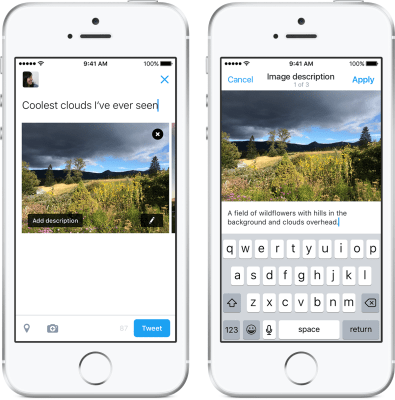Twitter this morning announced an effort to make its service more accessible to those who are visually impaired. Specifically, the company is now allowing users to add descriptions to images known as “alternative text,” or “alt text.” This lets people who are taking advantage of assistive technology, including screen readers and braille displays, the chance to hear what an image is about even when they can’t make out the details or see it.
To use the new feature, available in Twitter’s iOS and Android applications, you’ll have to first head into the app’s accessibility settings. From there, you’ll need to enable the option “compose image descriptions.” After this is turned on, you’ll then be able to add a text description the next time you add an image to go along with your tweet by clicking a new “Add description” button.
A change like this isn’t something everyday Twitter users will think about using, of course. However, those who run large accounts for publications, brands and businesses in need of reaching a wider audience will likely want to make sure their tweets and images are able to be seen and understood by all who use the service.
In addition to enabling the accessibility feature on the Twitter apps, Twitter says that it has also extended the ability to add alt text to images to both its REST API and Twitter Cards. That means publishers and third-party clients will also be able to take advantage of this new functionality. This is especially important because there are specialized Twitter applications designed for those who are visually impaired, including EasyChirp, Chicken Nugget, and The Qube, the company notes.
The move also signals an effort on Twitter’s part to respond to the unmet needs in the third-party developer community. After CEO Jack Dorsey announced last year that the company wanted to “reset” its relationship with developers, the company opened itself up to developer feedback via the #HelloWorld hashtag. Twitter later shared in October 2015 a list of developer requests, including thing like the ability to edit tweets, remove the 140-character limit, improve lists, make accessibility improvements to the product, improve search, among other things.
Twitter has since then been experimenting with a number of changes related to this feedback, including toying with the idea of removing the character limitations, but accessibility is the first of the requested high-level changes from developers to become an official part of Twitter’s product.
